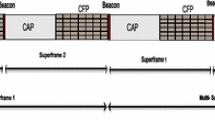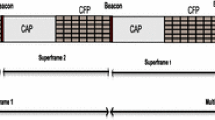Abstract
The IEEE 802.15.4 standard is known as the most used technology for Wireless Sensor Networks (WSNs) because of their low rate and especially their energy efficiency. To better support the requirements of Low Energy Critical Infrastructure Monitoring (LECIM) applications, the IEEE 802.15.4k is approved. This amendment is intended for critical packets transmission using the Priority Channel Access (PCA) that has become a real issue in infrastructures applications. The analysis presented in this paper investigates, for the first time in the literature, the performance analysis of the IEEE 802.15.4k in non beacon-enabled mode assuming star topology, saturated traffic and fading channel conditions. Where fading channel is a very important factor in the network as it affects its performance. We emphasize that this is an original work that has never been treated in literature. In this paper, we have developed a two dimensional Markov chain model for the IEEE 802.15.4k unslotted Carrier Sense Multiple Access with Collision Avoidance (CSMA/CA) with PCA backoff mechanism, and, a three dimensional Markov chain model for the IEEE 802.15.4k unslotted CSMA/CA mechanism. Furthermore, to test the efficiency of the proposed model, we have analyzed the impact of variation of network size, probability that the available packet is critical, Bit Error Rate (BER), and packet length on the reliability, power consumption and throughput in order to compare the performance of both mechanisms. With the increase of network size and packet length, it is observed that PCA achieves a reduction in energy, a higher throughput and a lower reliability compared to CSMA/CA. The obtained results are satisfactory because packet length and network size are the most important parameters in industrial applications especially in critical systems. Finally, a comparative table was given to compare the behavior of the IEEE 802.15.4k network in terms of performance metrics.















Similar content being viewed by others
References
Ishfaq A, Khalil S, Saif U (2016) Military applications using wireless sensor networks: a survey. Int J Eng Sci 6(6):7039–7043. https://doi.org/10.4010/2016.1678
Ramson SJ, Moni DJ (2017) Applications of wireless sensor networks—a survey In: International conference on innovations in electrical, electronics, instrumentation and media technology (ICEEIMT), IEEE, 2017, pp 325–329. https://doi.org/10.1109/ICIEEIMT.2017.8116858
Rajesh G, Chaturvedi A (2019) Correlation analysis and statistical characterization of heterogeneous sensor data in environmental sensor networks. Comput Netw 164:1–31. https://doi.org/10.1016/j.comnet.2019.106902
Zubiete ED, Luque LF, Rodríguez AVM, González IG (2011) Review of wireless sensors networks in health applications In: 2011 Annual international conference of the IEEE engineering in medicine and biology society, IEEE, 2011, pp 1789–1793. https://doi.org/10.1109/IEMBS.2011.6090510
Henna S, Sarwar MA (2018) An adaptive Backoff Mechanism for IEEE 802.15.4 Beacon-Enabled wireless body area networks. Wireless Commun Mobile Comput. https://doi.org/10.1155/2018/9782605
Ashwini R (2014) Application of wireless sensor network in home automation. Int J Comput Organ Trends 4(3):64–71. https://doi.org/10.14445/22492593/IJCOT-V9P301
Zhao G (2011) Wireless sensor networks for industrial process monitoring and control: a survey. Netw Protoc Algorithms 3(1):46–63. https://doi.org/10.5296/npa.v3i1.580
Gomes RD, Benavente-Peces C, Fonseca IE, Alencar MS (2019) Adaptive and beacon-based multi-channel protocol for industrial wireless sensor networks. J Netw Comput Appl 132:22–39. https://doi.org/10.1016/j.jnca.2019.01.025
IEEE 802.15.4 Standard, Part 15.4: wireless medium access control (MAC) and physical layer (PHY) specifications for low rate wireless personal area networks (LR WPANs). (2003) 1–670 https://doi.org/10.1109/IEEESTD.2003.94389
Alkama L, Bouallouche-Medjkoune L (2020) IEEE 802.15.4 historical revolution versions: a survey. Computing. https://doi.org/10.1007/s00607-020-00844-3
Alkama L, Bouallouche-Medjkoune L, Bachiri L (2020) Modeling and performance evaluation of the IEEE 802.15.4K CSMA/CA with Priority Channel Access mechanism under fading channel. Wireless Personnal Commun 155:527–556. https://doi.org/10.1007/s11277-020-07584-9
IEEE Std 802.15.4, part 15.4: Low-rate wireless personal area networks (LR-WPANs) (2011) 1–314 https://doi.org/10.1109/IEEESTD.2011.6012487
Sanaullah Chowdhury M, Ullah N, Ameen MA, Kwak KS (2014) Framed slotted aloha based MAC protocol for low energy critical infrastructure monitoring networks. Int J Commun Syst 27(10):1783–1797. https://doi.org/10.1002/dac.2435
IEEE Std 802.15.4k, Part 15.4: Low-Rate Wireless Personal Area Networks (LR-WPANs) Amendment 5: Physical Layer Specifications for Low Energy, Critical Infrastructure Monitoring Networks (2013) 1–149 https://doi.org/10.1109/IEEESTD.2013.6581828
Bianchi G (2000) Performance analysis of the IEEE 802.11 distributed coordination function. IEEE J Select Areas Commun 18(3):535–547. https://doi.org/10.1109/49.840210
Benslimane A, Rachedi A (2014) Rate adaptation scheme for IEEE 802.11-based manets. J Netw Comput Appl 39:126–139. https://doi.org/10.1016/j.jnca.2013.05.013
Martorell G, Femenias G, Riera-Palou F (2015) Non-saturated IEEE 802.11 networks a. Hierarchical 3d Markov model. Comput Netw 80:27–50. https://doi.org/10.1016/j.comnet.2015.02.003
Casares-Giner V, Martinez-Bauset J, Portillo C (2019) Performance evaluation of framed slotted aloha with reservation packets and succesive interference cancelation for m2m networks. Comput Netw 155:15–30. https://doi.org/10.1016/j.comnet.2019.02.021
Misic J, Misic VB, Shafi S (2004) Performance of IEEE 802.15.4 beacon enabled PAN with uplink transmissions in non-saturation mode-access delay for finite buffers In: First international conference on broadband networks, IEEE, 2004, pp 416–425. https://doi.org/10.1109/BROADNETS.2004.61
Sahoo PK, Sheu J-P (2008) Modeling IEEE 802.15.4 based wireless sensor network with packet retry limits In: Proceedings of the 5th ACM symposium on Performance evaluation of wireless ad hoc, sensor, and ubiquitous networks, pp 63–70. https://doi.org/10.1145/1454609.1454624
Pollin S, Ergen M, Ergen SC, Bougard B, Van der Perre L, Moerman I, Bahai A, Varaiya P, Catthoor F (2008) Performance analysis of slotted carrier sense IEEE 802.15.4 medium access layer. IEEE Trans Wireless Commun 7(9):3359–3371. https://doi.org/10.1109/TWC.2008.060057
Park P, Di Marco P, Soldati P, Fischione C, Johansson KH (2009) A generalized Markov chain model for effective analysis of slotted IEEE 802.15.4 In: 2009 IEEE 6th International Conference on Mobile Adhoc and Sensor Systems, IEEE, 2009, pp 130–139. https://doi.org/10.1109/MOBHOC.2009.5337007
Park P, Fischione C, Johansson KH (2013) Modeling and stability analysis of hybrid multiple access in the IEEE 802.15.4 protocol. ACM Trans Sensor Netw (TOSN) 9(2):1–55. https://doi.org/10.1145/2422966.2422970
Tavakoli H, Mišić J, Naderi M, Mišić VB (2016) Adaptive low-energy clustering in slotted beacon-enabled IEEE 802.15.4 networks. Wireless Commun Mobile Comput 16(4):393–407. https://doi.org/10.1002/wcm.2524
Lee WH, Hwang HY, Chong JW (2018) Runtime estimation of the number of active devices in IEEE 802.15.4 Slotted CSMA/CA Networks with Deferred Transmission and No Acknowledgment Using ARMA Filters, Wireless Communications and Mobile Computing 2018 (2018) 1–12. https://doi.org/10.1155/2018/5420876
Shu F, Sakurai T (2011) A new analytical model for the IEEE 802.15. 4 CSMA-ca protocol. Comput Netw 55(11):2576–2591. https://doi.org/10.1016/j.comnet.2011.04.017
Atmani M, Aïssani D, Hadjadj-Aoul Y (2018) Towards bandwidth and energy optimization in IEEE 802.15. 4 wireless sensor networks. Computing 100(6):597–620. https://doi.org/10.1007/s00607-017-0583-4
Feo E, Di Caro GA (2011) An analytical model for IEEE 802.15.4 non-beacon enabled CSMA/CA in multihop wireless sensor networks, Istituto Dalle Molle di Studi sull’Intelligenza Artificiale (IDSIA), Lugano, Switzerland, Tech. Rep 05–11
Di Marco P, Park P, Fischione C, Johansson KH (2012) Analytical modeling of multi-hop IEEE 802.15.4 networks. IEEE Trans Veh Technol 61(7):3191–3208. https://doi.org/10.1109/TVT.2012.2201221
El Korbi I, Saidane LA (2016) Enhanced energy computation of unslotted IEEE 802.15.4 under unsaturated traffic conditions In: 2016 International Wireless Communications and Mobile Computing Conference (IWCMC), IEEE, pp 976–981. https://doi.org/10.1109/IWCMC.2016.7577191
Chen Y, Wang Z-Y, Huang L (2016) Performance analysis of a non-beacon enabled IEEE 802.15.4 network with retransmission and ACK mode. arXiv:1609.01101. 1–48 https://doi.org/10.1109/LCOMM.2008.071870
El Korbi I, Saïdane LA (2017) Performance evaluation of unslotted CSMA/CA for wireless sensor networks: energy consumption analysis and cross layer routing. Int J Comput Netw Inf Secur 9(6):1–12. https://doi.org/10.5815/ijcnis.2017.06.01
Tall H, Chalhoub G, Misson M (2015) Implementation of IEEE 802.15.4 unslotted CSMA/CA protocol on contiki OS In: International conference on performance evaluation and modeling in wired and wireless networks, IJ of Engineering Research & Technology, Ed, no. 4, pp 1–5. https://doi.org/10.1007/s12243-016-0522-y
Ullah N, Chowdhury MS, Khan P, Kwak KS (2014) Multi-hop medium access control protocol for low energy critical infrastructure monitoring networks using wake-up radio. Int J Commun Syst 27(11):2536–2554. https://doi.org/10.1002/dac.2487
Okdem S (2017) A real-time noise resilient data link layer mechanism for unslotted IEEE 802.15.4 networks. Int J Commun Syst 30(3):1–15. https://doi.org/10.1002/dac.2955
Kiran MS, Rajalakshmi P (2018) Performance analysis of CSMA/CA and PCA for time critical industrial IoT applications. IEEE Trans Ind Inf 14(5):2281–2293. https://doi.org/10.1109/TII.2018.2802497
Ouanteur C, Aïssani D, Bouallouche-Medjkoune L, Yazid M, Castel-Taleb H (2017) Modeling and performance evaluation of the IEEE 802.15. 4e lldn mechanism designed for industrial applications in WSNS. Wireless Netw 23(5):1343–1358
Author information
Authors and Affiliations
Corresponding author
Additional information
Publisher's Note
Springer Nature remains neutral with regard to jurisdictional claims in published maps and institutional affiliations.
Appendices
Appendix A: Derivation of Eq. (49)
Appendix B: Derivation of Eq. (50)
Rights and permissions
About this article
Cite this article
Alkama, L., Bouallouche-Medjkoune, L., Atmani, M. et al. Performance analysis of the unslotted IEEE 802.15.4k MAC protocols under saturated traffic and fading channel conditions. Computing 104, 1891–1922 (2022). https://doi.org/10.1007/s00607-022-01074-5
Received:
Accepted:
Published:
Issue Date:
DOI: https://doi.org/10.1007/s00607-022-01074-5




